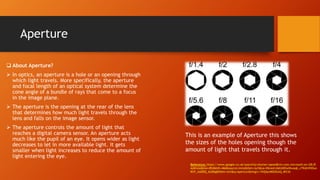A viewfinder is what photographers look through to compose and focus pictures. Optical viewfinders display around 90-95% of the image but LCD screens have advantages like convenience in bright light. Despite LCD benefits, pro photographers prefer viewfinders for steady shots without glare or drained batteries. A lens gathers and focuses light, with different types for purposes like wide angles, telephotos, and macros. An image sensor detects and conveys image information by converting light waves into electronic signals. Common sensor types are CCD, CMOS, and LiveMOS. The aperture is the opening at the rear of the lens that controls how much light reaches the image sensor.























